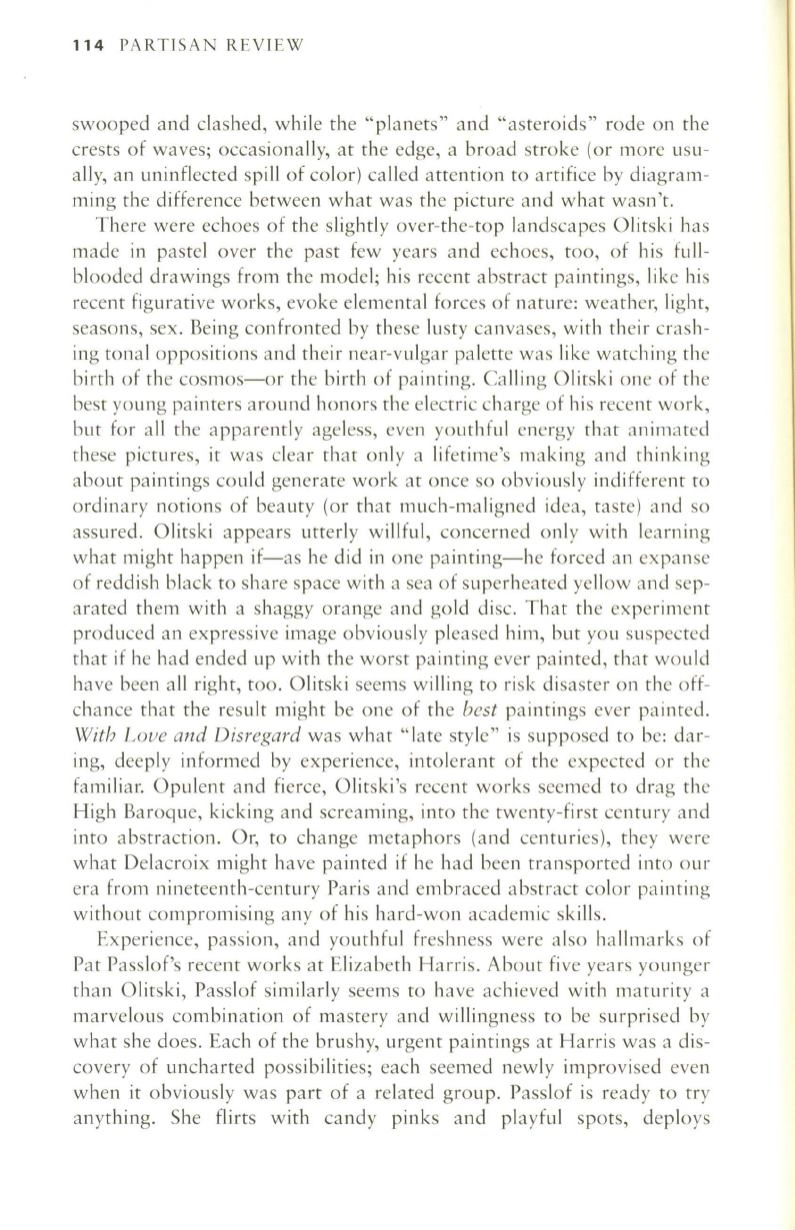
114
PARTISAN REVIEW
swooped and clashed, while the "planets" and "asteroids" rode on the
crests of waves; occasionally, at the edge, a broad stroke (or more usu–
ally, an uninflected spill of color) called attention to artifice by diagram–
ming the difference between what was the picture and what wasn't.
There were echoes of the slightly over-the-top landscapes Olitski has
made in pastel over the past few years and echoes, too, of his full–
blooded drawings from the model; his recent abstract paintings, like his
recent figurative works, evoke elemental forces of nature: weather, light,
seasons, sex. Being confronted by these lusty canvases, with their crash–
ing tonal oppositions and their near-vulgar palette was like watching the
birth of the cosmos-or the birth of painting. Calling Olitski one of the
best young painters around honors the electric charge of his recent work,
but for all the apparently ageless, even youthful energy that animated
these pictures, it was clear that only a lifetime's making and thinking
about paintings could generate work at once so obviously indifferent to
ordinary notions of beauty (or that much-maligned idea, taste) and so
assured. Olitski appears utterly willful, concerned only with learning
what might happen if-as he did in one painting-he forced an expanse
of reddish black to share space with a sea of superheated yellow and sep–
arated them with a shaggy orange and gold disc. That the experiment
produced an expressive image obviously pleased him, but you suspected
that if he had ended up with the worst painting ever painted, that would
have been all right, too. Olitski seems willing to risk disaster on the off–
chance that the result might be one of the
best
paintings ever painted.
With Love and Disregard
was what "late style" is supposed to be: dar–
ing, deeply informed by experience, intolerant of the expected or the
familiar. Opulent and fierce, Olitski's recent works seemed to drag the
High Baroque, kicking and screaming, into the twenty-first century and
into abstraction. Or, to change metaphors (and centuries), they were
what Delacroix might have painted if he had been transported into our
era from nineteenth-century Paris and embraced abstract color painting
without compromising any of his hard-won academic skills.
Experience, passion, and youthful freshness were also hallmarks of
Pat Passlof's recent works at Elizabeth Harris. About five years younger
than Olitski, Passlof similarly seems to have achieved with maturity a
marvelous combination of mastery and willingness to be surprised by
what she does. Each of the brushy, urgent paintings at Harris was a dis–
covery of uncharted possibilities; each seemed newly improvised even
when it obviously was part of a related group. Passlof is ready to try
anything. She flirts with candy pinks and playful spots, deploys


